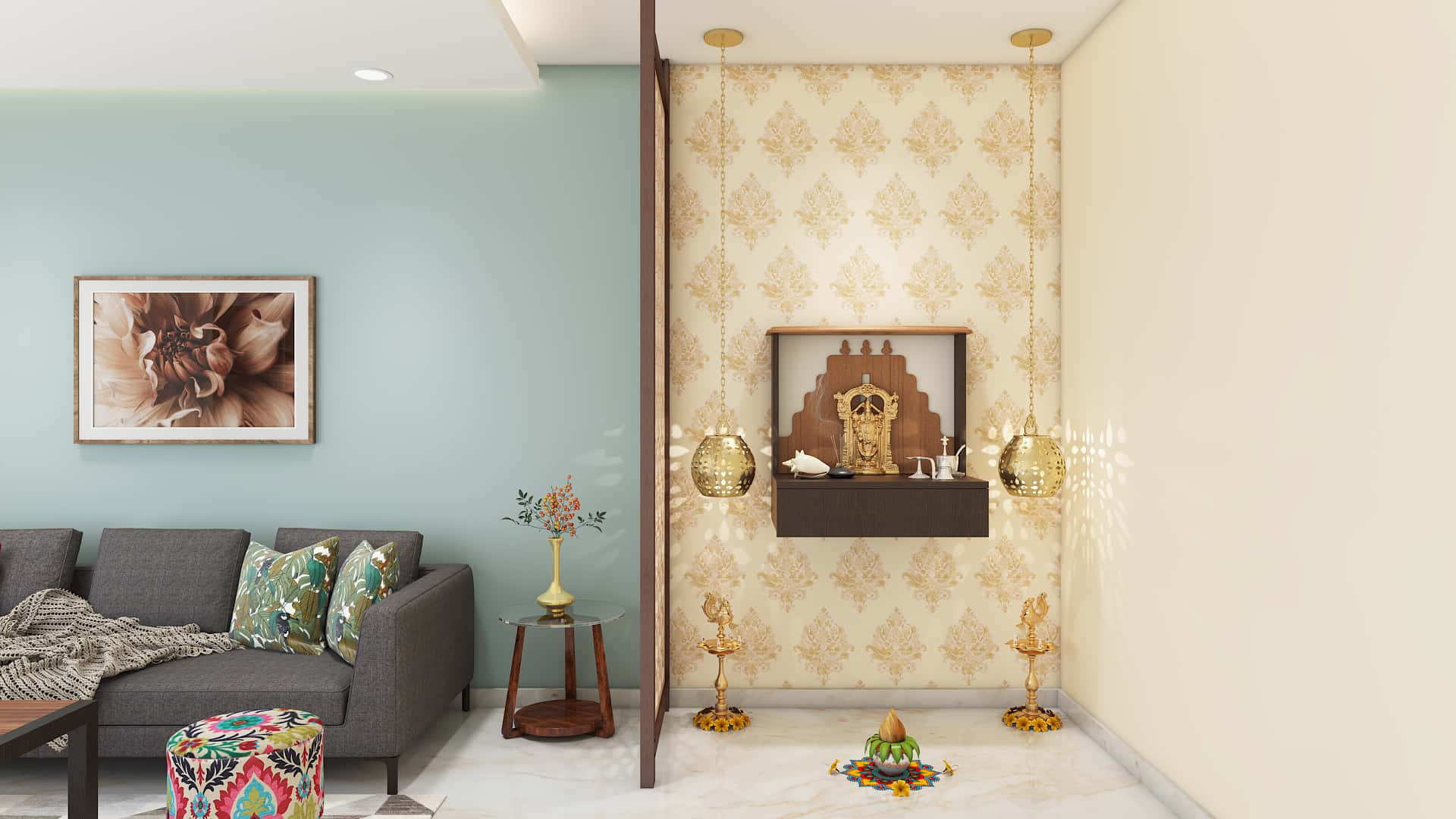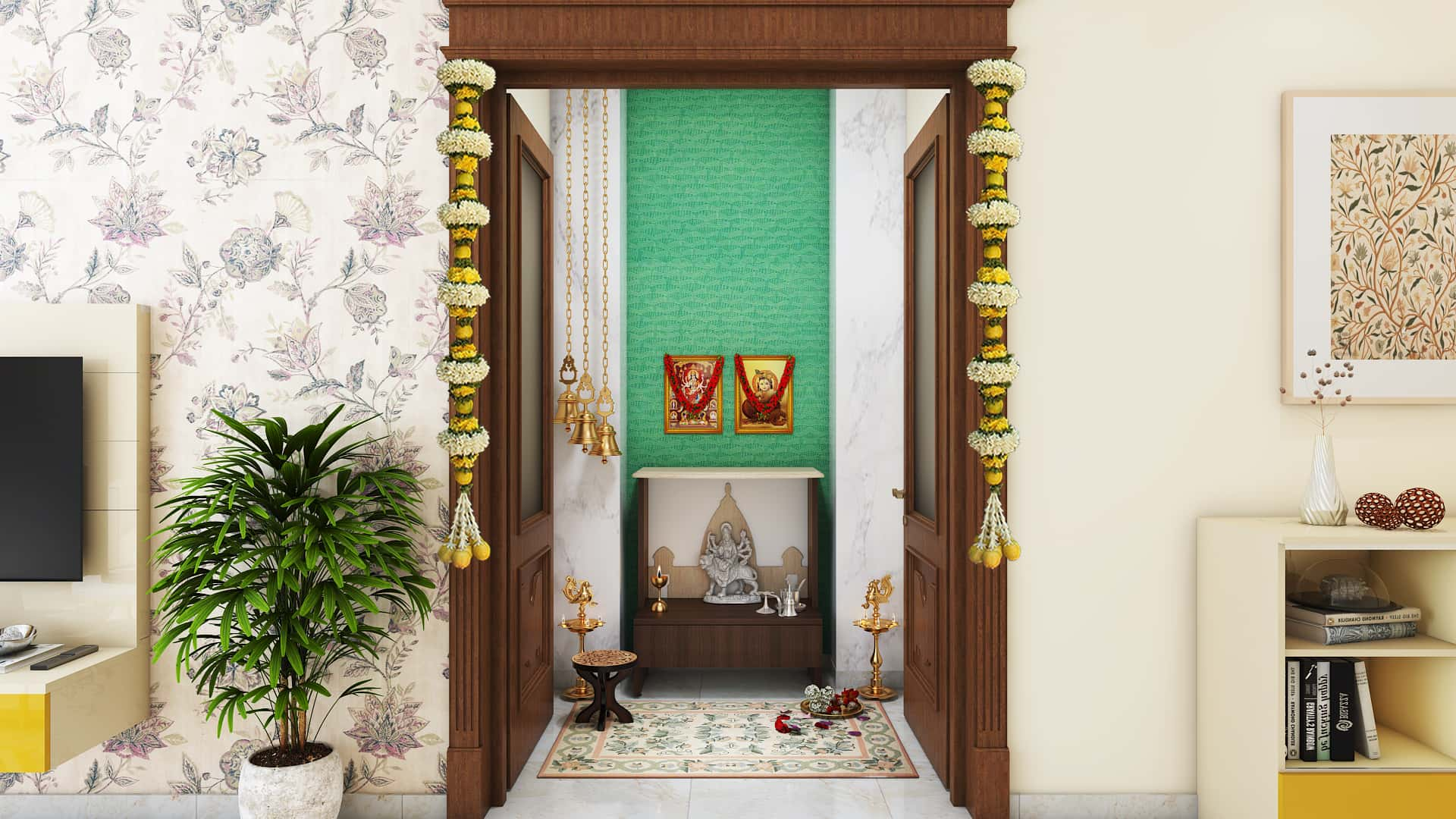Colours have a direct impact on your mood, behaviour, and feelings, according to research. And one space that should definitely reflect serenity and peace in every sense of the word is your pooja room. In this handy guide, we will look at some of the most effective pooja room colour combinations. These colour combinations for the pooja room will help you transform it into an oasis of happiness. Let’s get started.
Shades of White for All-Things Pure
Nothing says purity like a pooja room done up in shades of white. The colour accentuates the ‘essential’, so you can never go wrong with this classic colour. If you’re sceptical about going all-white, remember that you can always experiment with light wall textures and patterns, as you can see here:
Plus, note that a white pooja room colour combination will be minimalistic in style, execution, and approach. It will help capture the light and literally illuminate the space. This pooja room colour design also works if you want the sole focus of the pooja room to be your idols.
As a pro tip: Remember that a white pooja room will be relatively more high maintenance.
This is why you should opt for materials that are durable and easy to clean, such as marble, laminate, or glossy paints. Remember that white is the colour of transparency and transcendence, all at the same time.
Rich Gold for the Zingyness of Yellow and a Luxurious Feel
If you want to channel feelings of luxury and grandness with regard to the pooja room colour combination, it makes sense to go the gold route as opposed to using bright yellow. Moreover, the colour gold is the best in the backdrop and can effectively reveal the idol’s radiance if used aesthetically, as shown here:
Gold is the colour of elegance and epitomises magnificence and shines like no other colour–much like the idols you worship within your pooja room. Remember that you can use gold in multiple ways. For instance, go for gold metalwork to avoid overshadowing your idols; you don’t always have to go the ‘paint’ way to add colour:
Cream and Beige: The Warmest and Simplest Pooja Room Colour Combination for Your Place of Worship
Using shades of cream and beige for your pooja room is the best colour combination for the pooja room for people who love keeping their interiors in line with the ‘natural’ tone. Beige and shades of cream act as a counterpoint and an element of neutrality against the backdrop of the sacred white colour. This pooja room colour combination adds a sense of heightened elegance. This elegance is a little less ‘in-the-face’ than gold and a little more sophisticated than the jarring bright yellow colour:
You can play with shades of beige across diverse elements within your pooja room, such as the blinds, the lighting, the marble area where the idols would sit, and so on. Always go for complementary shades of the beige and cream family colour to prevent monotony and add layers of subtle texture.
Dual Tone Colours for Adding Vibrancy
Often, people shy away from using starkly bright colours (think: orangey hues or rich red) because they fear it will look ‘too much’ for a place of worship–understandably so. If you do wish to add a pop of colour, the trick lies in using dual pooja room colour combinations.
This will allow you to seamlessly add brighter colours, such as red with a more neutral colour, say beige or even white, without making the pooja room feel too harsh or, worse, dominating. Here’s an excellent example of a pooja room colour combination that freely uses a brighter shade of orange without any inhibitions and immediately adds vividness to the overall look and feel:
In fact, the colour orange is known to be a popular Vastu colour for pooja rooms. This is hardly surprising since one of the most commonly used flowers in the pooja room is the marigold flower, which is as auspiciously orange colour as they come. All in all, the colour orange extends a pious and venerated look in the pooja room.
Blue or Green Pooja Room Colour Combination that Exudes Character and Life Itself
If you think blue and green (used separately) are not suitable pooja room colour combinations for your pooja space, the following images will make you think again:
Granted that blue is an offbeat colour, it works swimmingly well if the interiors of the space next to the pooja room permit so. Blue is known to make you more mentally alert, as per research.
The colour green, on the other hand, can effortlessly infuse life into your pooja room:
Green is the symbol of nature and life itself, so it makes aesthetic sense to add a gorgeous shade of green to your pooja space. If you want to inject fresh, divine energy into your pooja room, we suggest you go for warmer shades of green. You won’t regret it.
The pooja room should be designed to exude calm, peace, positivity, and serenity within the house. And the pooja room colour combination you choose will have a positive (or negative) effect.
In other words, it can influence your mood, so make sure to choose the colour palette that feels right to you. Get in touch with the experts at HomeLane to find the right choice for your pooja room colour combination.
FAQs
1. Which is the best colour for a pooja room colour as per Vastu?
The colour white is the best colour for a pooja room, as per Vastu. This is the best colour for the pooja room, as per Vastu, because the colour white signifies purity and peace and will help you create a sacred space for worship.
2. Which colour is best for a home Mandir?
The colour orange is best for a home Mandir. The colour orange signifies auspiciousness and will also give a luxurious and elegant look to your home mandir. It is also easy to design, as many colours go well with orange.











